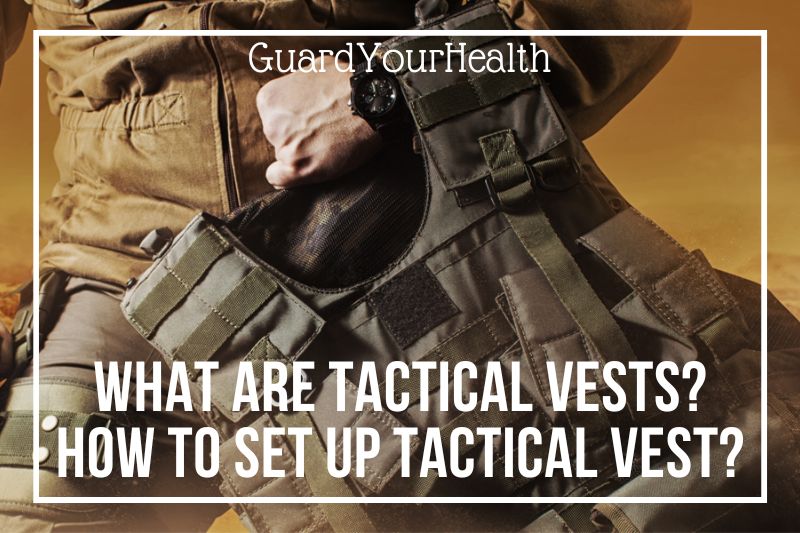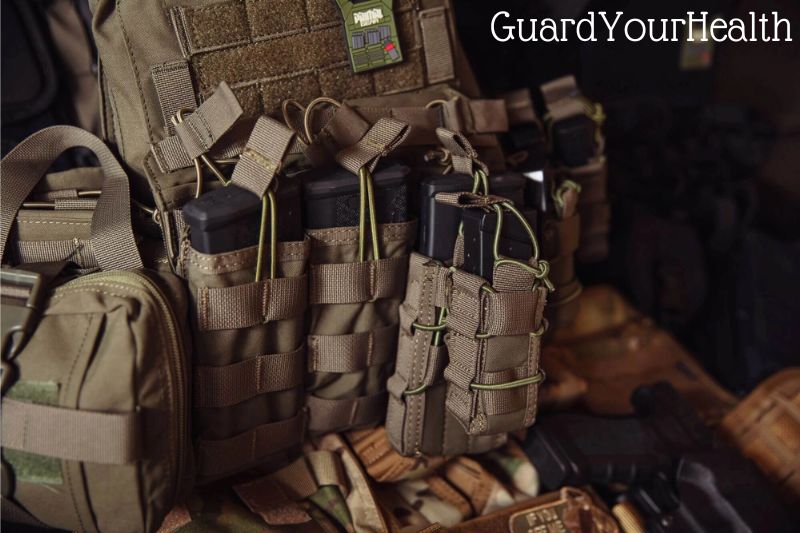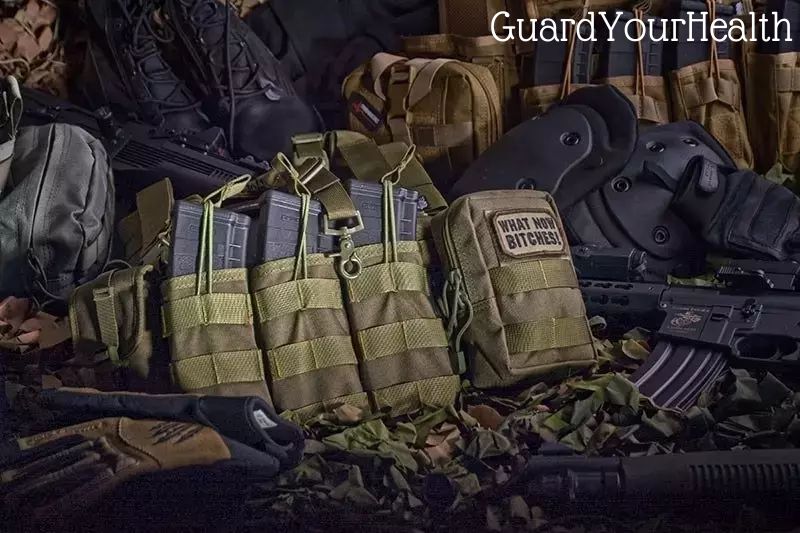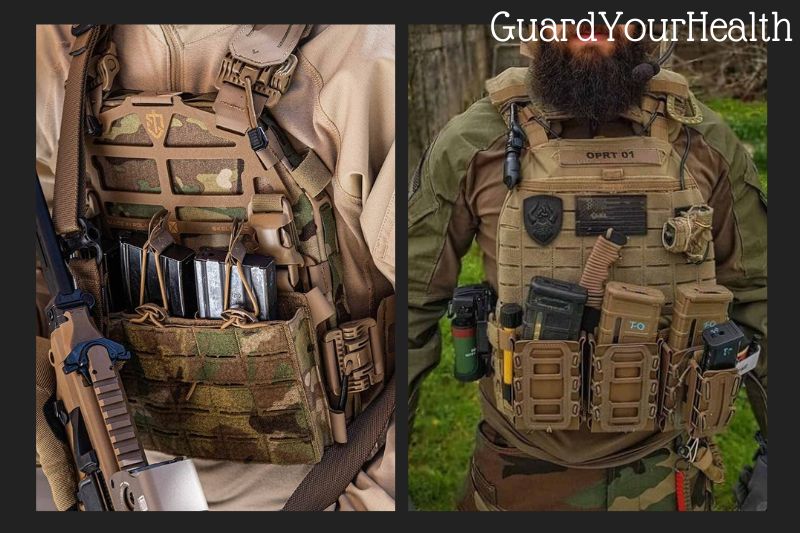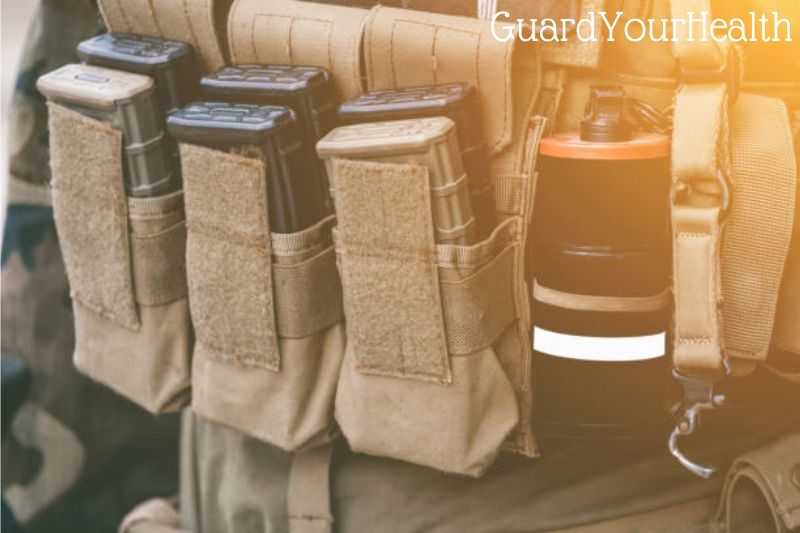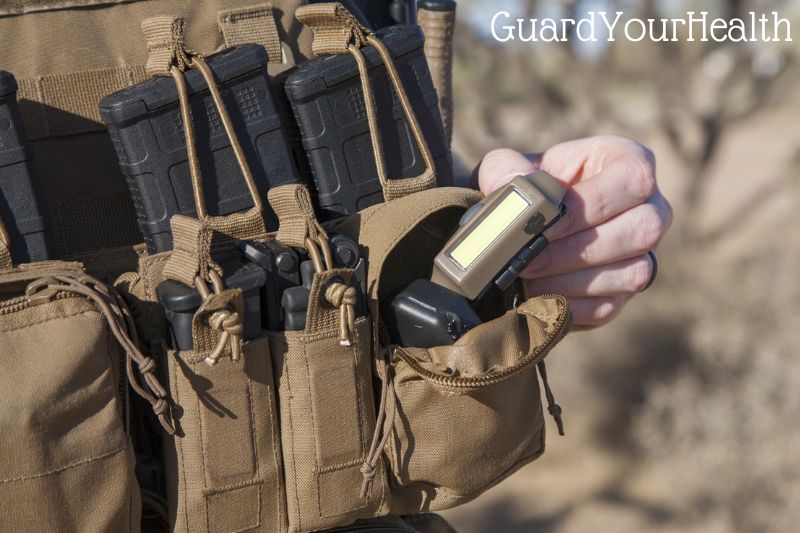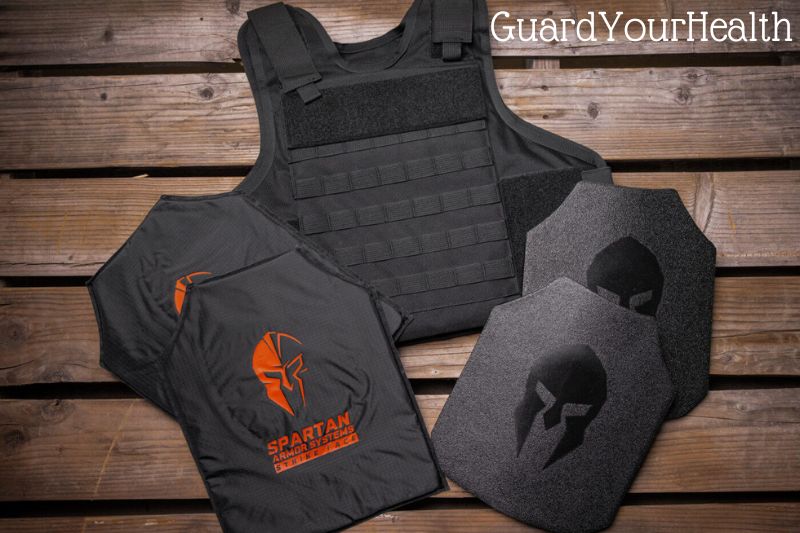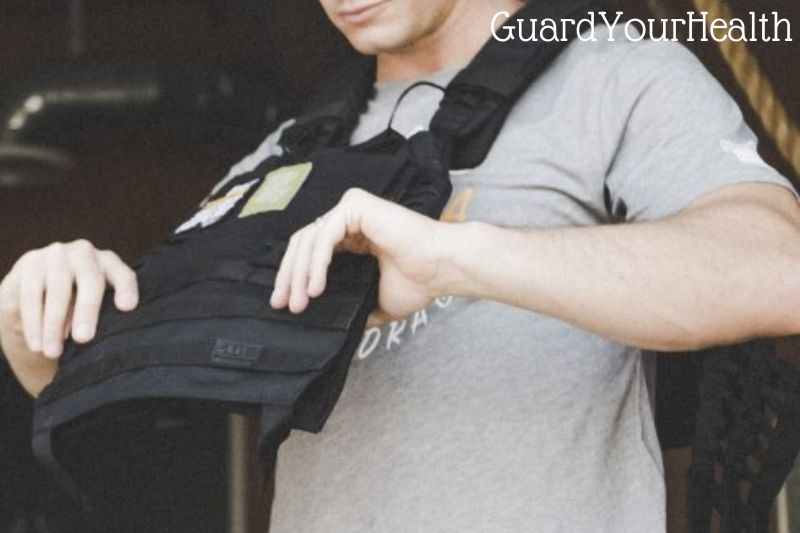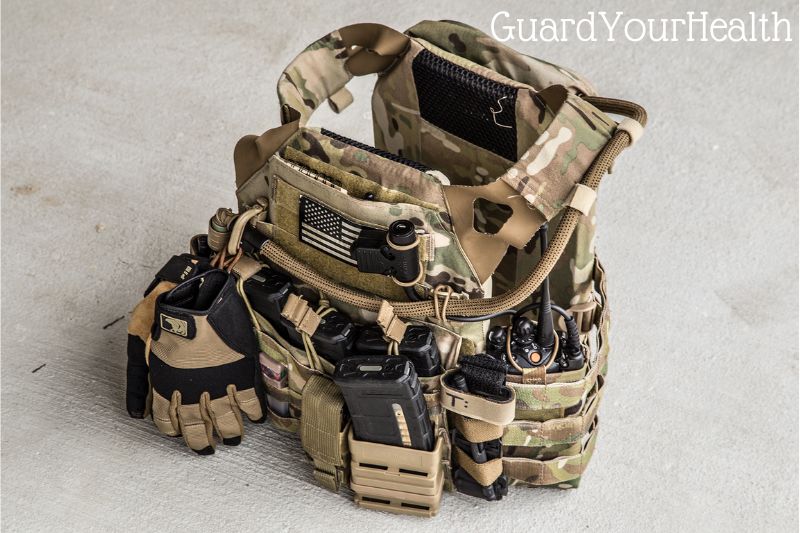A tactical vest is a piece of body armor that is designed to protect the wearer from ballistic and other types of attack. The vest is typically made from Kevlar or other ballistic material and is worn over the torso. Tactical vests are often used by military and law enforcement personnel and are often equipped with various pockets and pouches for carrying equipment.
In this blog post, GuardYourHealth will guide you on how to set up tactical vest and provide what to carry in a tactical vest.
What Are Tactical Vests?
Tactical vests, known as Heavy-duty vests, are worn by members of the armed forces, police enforcement, and private security.
In recent years, civilians have also started using them for cosplay, CS games, trekking, hunting, fishing, and other activities.
These practical vests are simple to wear over everyday attire. They contain numerous compartments of various sizes for carrying any gear or equipment you would require. Bulletproof plate pockets are available on several vests.
The material used to make tactical vests is breathable, light, and strong enough to contain all of your gear without adding bulk to you.
Modern tactical vests have right- and left-hand holsters that can snugly fit pistols and medium to big firearms if you need to carry a weapon.
Modular Lightweight Load-Carrying Equipment (MOLLE) or a Pouch Attachment Ladder System (PALS) are typically found on tactical vests. These are ways to attach webbing pouches to carry more tactical equipment.
Some people confuse plate carriers for tactical vests and vice versa. Even though some tactical vests have pockets for holding plates, they are not completely bulletproof.
The vest is divided into two areas by a zipper so that each hand can readily access one of them. Tac vests are composed of lightweight, breathable material because they are intended to be worn even in hot weather.
In contrast, plate carriers are bulky, inflexible vests attached to the front and rear with bulletproof plates. Military and law enforcement officers favor them as body armor.
For additional weight and resistance, fitness aficionados also employ plate carriers in their workouts.
- Read also: ceramic vs steel body armor
What Is the Best Tactical Vest Setup?
Let’s start by dispelling a common misunderstanding: there isn’t a single, ideal way to configure your tactical vest.
Everybody has their own preferences for how they wear and use clothing, and the same is true for tactical vests.
Your tactical vest should be set up according to your preferences and to provide the most benefit for the intended application.
For instance, if you plan to carry firearms, your tactical vest needs to be loaded so that you can quickly access your weapons.
It is up to you to organize the various pockets in a tac vest so that they can hold the tools and supplies you’ll need for your journey.
Don’t worry if the idea of designing your own tactical vest setup makes you feel overwhelmed. This tutorial will walk you through each crucial factor you should take into account to get the ideal configuration for you.
Choosing the Correct Size
Start by selecting the appropriate vest size. Examine how each fit feels on your shoulders and chest as you try on a few.
Be sure to take off the ballistic plates and other attachments before getting measured or finding the right fit. Your vest should be loose-fitting and completely enclose your torso.
Our advice Consider what you will be doing and how long you will be wearing the vest. As you try on various sizes, this should make it clearer what level of comfort and movement you like.
The majority of tactical vests have an adjustable waist and shoulder straps. These straps should only be used for very few adjustments, though.
You wouldn’t want to be stuck with an uncomfortable vest if the straps malfunction or break during your tactical activity.
How should a fitting tactical vest look? Here are some things to think about:
Place the shoulder pads on your shoulders so that they are snug.
The top of your front plate should be adjusted so that it rests two fingerbreadths below your collarbone. The vest should push against your body when you breathe in, but it shouldn’t restrict or stop your breathing.
The vest’s back should be level with its front.
Any side panels should be adjusted, so they fit your body properly.
When evaluating the fit of your vest, move about a bit. Stretch your body in various directions and make sideways, forward, and backward bends. To test how the vest will move with your body, jog or walk around.
You need a larger size if the vest hinders your movement in any manner. The vest is the ideal fit if it doesn’t restrict your movement when you’re wearing it.
Configuring Your Items
How should everything be arranged within your tactical vest?
Loading several tools Willy-nilly storage will make it very challenging to locate anything later. When you’re looking for anything, you don’t want to have to spend time searching through all of your pockets.
Here’s what you ought to do in its place.
- Set up all the equipment and supplies you’ll need for your trek, expedition, or mission.
- Mark the things according to importance and usage frequency.
- Recognize the locations of the pockets on your tactical vest.
- Purchase any additional accessories you might require to store your equipment.
- Put on your tactical vest and make the necessary adjustments.
- Put the vest on and the accessories in the pockets to see how easily and comfortably you can reach for what you need.
The optimum configuration is one in which all of your commonly used objects are on the front of the vest or at the sides within easy reach of your dominant hand. You can place the less-used items on the rear.
You should be able to develop a natural arrangement where it just takes a few seconds to grab anything with a little bit of trial and error.
Your ideal tactical vest configuration can be determined through a type of dress rehearsal. Practice all of your routine motions, including sprinting while wearing a vest, switching magazines, and other on-the-go tasks.
You can then make any necessary modifications before donning your tactical vest and going on a ride.
Detachable pockets on tactical vests are available for you to use or discard as you see fit. Because you’ll be carrying everything for hours at a time, take care not to overstuff your vest.
If you’re unable to unload some of your gear, make sure to organize it carefully to keep the vest’s weight distribution balanced.
Important Accessories for Your Tactical Vest
Unsure of what gear a tactical vest can accommodate? Here are some necessities you should pack depending on the purpose of your trip:
- Flashlight
- Compass
- Hydration bladder
- Notebooks
- Pepper spray
- Keys
- Leatherman multi-tool
- Medical pouch
- Radio or GPS holder/pouch
You will require the following if you intend to use your tactical vest for combat:
- Ballistic plates
- Pistols
- Extra magazines
- Handcuffs
- Baton
- Taser
- Field trauma kit
Can a Tactical Vest Have a Plate Attached?
If a tactical vest has room for one, you can add a plate to it. But not all tactical vests include pockets for plate carriers.
The front and rear of tactical vests made specifically for battle contain pockets for plate inserts.
However, those designed for straightforward cosplay, computer games, hiking, and trekking will not have plate pockets.
A critical step in tactical vest setup is choosing the proper plate to fit your vest and protect your body.
Cuts in ballistic plate
Ballistic plates are designed to shield your important organs from ballistic strikes. The size of the plates’ cuts has a significant impact on the degree of protection.
Here are some of the several plate cuts available in stores.
Full Cut: This square or rectangular plate guards against ballistic attacks on your back. If quick movement is a priority for you, this plate cut is not the best.
Shooter’s Cut: This is shaped like a rectangle, allowing the wearer greater flexibility when using a gun.
Swimmer’s Cut: In terms of mobility, a swimmer’s cut is superior to all other plates. The wearer has more freedom to move around thanks to it. Sadly, it has the drawback of providing less protective coverage.
The Small Arms Protective Insert (SAPI) Cut is comparable to the swimmer’s cut in that it allows the wearer to move their arms with ease. Due to its higher 45-degree cut, the SAPI manages to do this without sacrificing the coverage of important organs. Armed forces and law enforcement members frequently use the SAPI cut.
Side plates: In addition to front and back ballistic plates, side plates are designed to be attached to the sides of a vest to offer protection. Although they cover more torso surface area, they greatly increase the size and weight of a tactical vest arrangement.
How a Tactical Vest Works
The conventional tactical vest doesn’t appear to have much to offer at first glance. A typical police tactical vest may appear a little big and thick, but that’s primarily due to the numerous layers of cloth that offer some protection from tiny gunshots.
However, the tactical vest’s modularity is where its greatest value lies. Most tactical vests manufactured and sold in the US and Europe use the PALS or Pouch Attachment Ladder System. This is the standard design for a modular system of accessory attachments for the United States military use on load-bearing military clothing.
PALS is a collection of nylon webbing strips stacked in a ladder arrangement, as the name implies. These strips are sewn shut at regular intervals and connected to the wide, flat portions of a tactical vest or bag.
This leaves exposed areas of the webbing where pouches, holsters, carabiners, and other accessories can be fastened. This system’s simplicity and standardization make it very simple for the user to create custom tactical vest configurations that meet their unique work requirements.
Watch the video to easily set up your tactical vest:
FAQs
What Is The Purpose of A Tactical Vest?
A tactical vest is a robust vest that can be worn over everyday clothing to offer protection and a means of carrying supplies while on duty. It features a number of pockets with different sizes to accommodate all the necessary equipment.
Is Tactical Vest Better Than Plate Carrier?
Tactical vests are lightweight and perfect for quick missions, while plate carriers are often bulky and offer great ballistic protection. The weight, MOLLE, and other aspects of both of these body armors are also different.
How Much Does A Tactical Vest Weight?
A fully equipped IOTV still weighs 30 pounds (14 kg), with a large IOTV weighing roughly 35 pounds. This is because it has all of its components, including soft armor panel inserts, four ballistic plate inserts (front and back plates and two side plates), collar, and groin protection (16 kg).
Conclusion
The tactical vest is an important item that shouldn’t be taken lightly because it is the dependable carrier of your necessary gear. Your tactical vest will let you move more quickly and effectively on the field with sufficient setup command.
Hopefully, this guide can bring the top of the necessary information for you. If you have any questions, feel free to leave your comments below. Thanks for reading

